In an era of healthcare when there is a call for emergency physicians and hospitalists to increase collaboration, and many working hard to facilitate this, I have seen this pairing blend together effectively just by putting together highly motivated and empowered physicians.
In 1996, my physician group signed an emergency department (ED) contract in Selma, CA. Since that time, we have been invited to staff three EDs, three inpatient departments, an urgent care center (UCC) and a skilled nursing facility (SNF)—all within the forty mile area that includes Selma. How did this come about?
When the administration at Selma saw good patient care metrics in their ED, they asked us to manage their hospitalist service, too, on the premise that what is good for outpatients is good for inpatients. And, sure enough, within six months, not only did throughput time decrease in the ED, but hospital length of stay decreased also. The Case Mix Index (CMI) for the hospital increased, but still our cost per patient has decreased. Our style of coordinating care in the ED was successful in coordinating care throughout the hospital.
What is it that has enabled us to improve performance in a range of different enterprises with different missions and different metrics? ED physicians, hospitalists and SNFists have diverse skill sets and perform varied functions, but at the end of the day, they are all similar in that they want to be empowered as physicians and be leaders in the community. I have seen physicians gravitate towards a physician-led group with a democratic structure. In this case all the physicians own their practices. When we work for ourselves, we have a very demanding boss! Self-employment gives people that extra bit of motivation to work well and efficiently, and to become leaders in the community. This not only attracts physicians to work with us, but it attracts hospital administrators who want us to work with them.
So how does a physician group handle it when the hospital asks for more and more inter-departmental integration and collaboration? I know this: when physicians feel as if they own their own practice, they are empowered and motivated to come up with solutions that work. I have seen with my own eyes what happens when the collective power of physicians is brought together.
Managing from the viewpoint of the Acute Care Continuum (and beyond) can allow the coordination of care in a way that has not been possible since family doctors managed their own patients twenty years ago. Now we are creating a culture of integration that coordinates all episodes of care from the ED, through the hospital, and right through to the SNF. While there can be challenges in coming together in this way, I have seen no negatives as a result of doing this, and, to the contrary, much in the way of positive results. Think of it as a jazz band. We in the ED played the piano so well that we were asked to play the clarinet, too, and then the trumpet, and each player, playing independently, contributes to a wonderful sound.























